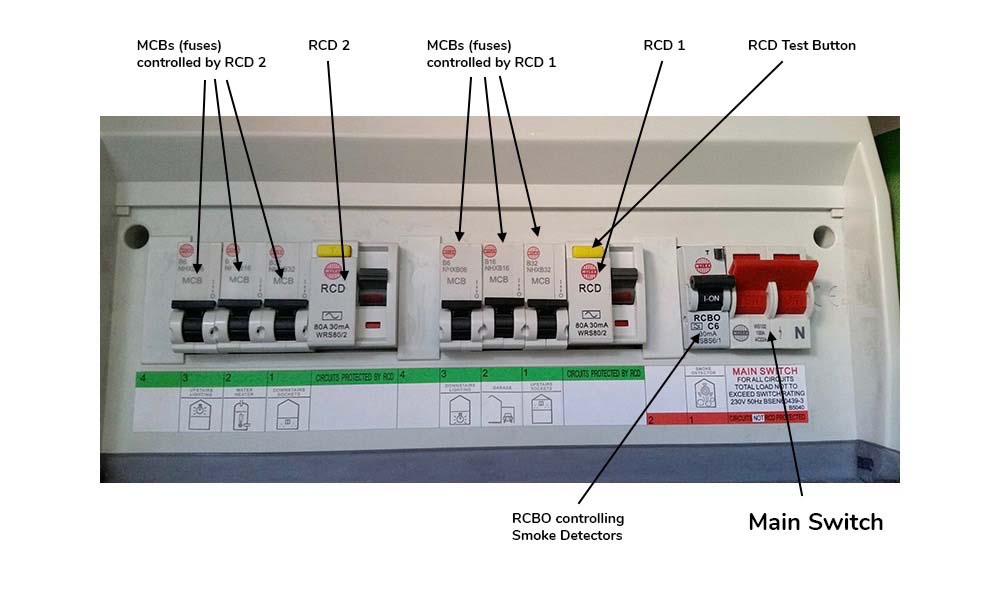I can’t promise that this is going to be an exciting read. I’ll do my best, but, unless you’re a complete electrical nerd, this is probably not going to really light your fire.
However, it may get you out of a tight spot in an emergency, and save you alot of money. Faced with a sudden loss of power, many people, understandably, panic and call out an electrician, when, with a little knowledge & patience, they can sort the issue themselves.

What is an RCD?
It helps you know why we have an RCD, or Residual Current Device. Its a safety device which is now, fortunately, pretty common in most domestic electrical supplies.
If you’re not sure whether you have one, it should look something like this:
There will usually be a small reset button on it, sometimes red, yellow, blue or black – basically down to manufacturer’s preference. This button should have TEST written somewhere near it. As the name suggests, this button allows you to test that the RCD trips.
It will either have RCD, RCCB or RCBO written on it.

How does an RCD work?
An RCD measures the current in the circuits that it controls. It measures the current leaving and returning. If there is an imbalance, it assumes that some of the current has leaked out and is causing a danger. (Leaking current could be going into an object that you may touch, such as metallic light fitting, or into you, because you are laready touching it). This is generally regarded as a very bad thing.
The current is immediately (or, at least within a few milliseconds) switched off and there is no longer any power.
This bascially means that you won’t be electrocuted, and is therefore a very good thing.
How do I reset an RCD?
RCDs are designed to be reset. Sometimes they trip for no apparent reason. They can be tripped by a lightbulb blowing. It isn’t always an indication of a problem.
Nerd alert….
Just as an aside that you can happily skip until another day…. the number of electronic pieces of equipment that we have in our houses these days is creating a problem for older style RCDs. Electronic equipment often leaks a bit more current to earth than these RCDs, can deal with, so we are likely to get more nuisance RCD tripping than we used to. This is being addressed by the introduction of new types of RCD that can identify this kind of earth leakage. These are now being installed in new installations as a matter of course. However, if you have an older type of consumer unit, and you are getting regular RCD tripping, it may be time to call in an electrician to help you deal with it).
Anyway, back to the real reason we’re here…..
If the lever on an RCD is in the DOWN position, it is OFF. To reset it, the lever simply needs to be pushed back UP.
Useful tip: For some RCDs, it is necessary to push the lever fully downwards before it will let you push it back UP and reset.
In many cases, this will be fine. The RCD will reset and all will be well. You can now stop reading, pat yourself on the back & go and put the kettle on.
My RCD won’t reset. What should I do?
When I am called to a house where an RCD keeps tripping, this is the first question I ask:
What happened just before the RCD tripped?
It probably seems obvious, but when you’re dealing with what seems like an emergency, we often miss the obvious. Let’s face it. RCDs don’t trip when you have time to deal with them, they choose the most inopportune moments, such as when you’e about to put the turkey in the oven on Christmas Day, or when the kids are filthy dirty from some sporting activity, and need to get into the bath. The pressure is on, and you don’t have time to think.
If you were in the house when the RCD tripped, ask yourself what happened just before the RCD tripped. If you had just turned the Kettle on, or switched on the Iron or (common culprit) Hair-straighteners, there’s a possibility that this may be the cause of the problem. Do the obvious thing, and fully unplug the Kettle/Iron/Hair-straighteners and reset the RCD. (i.e switch off and remove the plug from the socket).
If the RCD resets and stays reset, then you have probably found your culprit.
The problem appliance can be dealt with in slower time. You have power, so you can pat yourself on the back, stick the kettle on (unless its the culprit) & move on.
The next question you might want to ask yourself is….
Did I just drill through a cable?
If you just drilled through a wall and the RCD tripped, there may be a strong link between the two events. It is quite possible that you may have drilled through, or otherwise damaged a cable. If you didn’t check the positions of cables prior to drilling, you have just learnt a useful, but possibly quite expensive lesson. Its time to call in an electrician to repair the damaged cable as soon as possible. It is quite possible that the RCD will not reset until the damage has been repaired.
Next time you get the drill out, it would be worth checking out one of our other posts on the inappropriately named Electrical Safe Zones. Contrary to their name, these are areas where it is actually dangerous to drill, as they could legitimately hide cables.
If you look at the Electrical Safe Zones. post and realise that you did, in fact, drill straight into one of these safe zones, please call an electrician as soon as possible. There may be some brown scorch marks, or even a bit of smoke coming out of the hole – all signs that things are not well.
How do I identify the cause of the fault?
If neither of these scenarios applies and the RCD seems to have tripped for no reason at all, there is a straightforward procedure to follow, which in most cases will identify where the problem lies.
Stage 1:
Your Consumer Unit should be properly labelled. The RCD will be labelled and the fuses (or MCBs) controlled by it, also labelled. Hopefully it will look something like this:

Make a note of the names of the circuits which are covered by the RCD.
Firstly switch off the RCD and all the fuses (MCBs) controlled by it. All the levers should be pointing DOWN
In this case, lets imagine that RCD 2 is the problem. The circuits covered by RCD 2 are:
- Downstairs Sockets
- Water Heater (Probably the Boiler)
- Upstairs Lights
Turn off all those fuses (Lever pointing DOWN). Then unplug everything that is plugged into the Downstairs Sockets.
If the Boiler is also not working, and you don’t have an immersion heater in your house, it is quite likely that the “Water Heater” circuit applies to the Boiler. If it is plugged in, pull the plug out. If it has a fused spur, then pull the fuse out of the fuse holder on the fused spur.
Stage 2:
Now, we need to identify which circuit is causing the problems.
Start with the Downstairs Sockets.
First turn on the fuse (MCB) for the downstairs sockets, and see if the RCD also stays on.
If it doesn’t stay on, check that you have definitely unplugged everything on that circuit.
- Might there be something plugged in in a cupboard that you had forgotten about?
- Is there an outside socket?
- Are the lights under the kitchen cabinets run from a fused spur in the Kitchen?
It is very easy to miss something at this stage, so you may have to really rack your brains. Cooker Hoods are an easy one to miss.
If you are pretty sure that everything has been unplugged and you still can’t reset the RCD, it is time to call an electrician. This scenario (which is pretty unlikely) would suggest that there may be a problem with the wiring or something on the circuit.
If the RCD remains on, then go round and plug in each of the appliances that you previously unplugged. Switch each one on. If at any stage, the RCD trips, you have found your culprit.
If the RCD remains on while you plug everything back in, it appears that the problem isn’t on this particular circuit.
Stage 3:
Move on to the next circuit and do the same thing.
In this case, it is the boiler circuit, so it will just be a case of putting the fuse back in and switching the boiler on.
If the RCD trips at this point, there could be an issue with the boiler. Take a look to see if there are any signs of water under the boiler. A leak from a boiler onto the controls is a common cause of this kind of problem. If you suspect that this is the case, you need to call a Gas or Boiler Engineer.
Stage 4:
Finally turn on the third circuit. In this case, it is the Upstairs Lighting Circuit. To save time, you have left all the light bulbs in their fittings. If the RCD trips when you turn the fuse (MCB) for the lights back on, take all the lightbulbs out, just in case one of them is causing a problem, and switch the Fuse back on.
If the RCD stays on, put each light bulb back into its fitting in turn. For safety’s sake, make sure that you turn the fuse (MCB) off each time that you put a bulb in, and turn it on once the bulb is in position. If the RCD trips when you put one of the bulbs back in, then that will be your culprit.
By this stage, hopefully, you may have identified your culprit. However, if the RCD is still not resetting, or turns back on and continues to trip, then it is time to call out an electrician.
Don’t despair…..
You have already saved yourself some money. You have gone through a methodical series of tests to eliminate any obvious issues.
You can tell an electrician exactly what you have done and what the outcome was. This means that the electrician already has a lot of really useful information before they start looking themselves. Believe you me, that makes an electrician’s job an awful lot easier.
Under no circumstances should you start taking a look inside any electrical fixtures and fittings yourself. This is a very dangerous thing to do, if you don’t know what you’re doing. Let’s be honest, you probably wouldn’t know if you were looking at a problem anyway, so why put yourself at risk?
Plumbing issues are generally pretty easy to see – dripping water is pretty visible, & gives you an immediate clue about where to start looking.
Electrical issues are a lot more difficult to find. Electrical fault finding is very like detective work. Any clues that you, as the householder can give, will speed the process up, and ultimately save you money.
